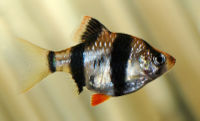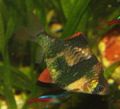Difference between revisions of "Puntigrus tetrazona"
From The Aquarium Wiki
m (Added "including most other barbs of similar size.") |
|||
| (3 intermediate revisions by 3 users not shown) | |||
| Line 4: | Line 4: | ||
|extra_common_names=Tiger Barb, Green Tiger Barb, Black Tiger Barb, Sumatran Barb, Sumatra Barb, Moosbarbe, Gold Banded Barb | |extra_common_names=Tiger Barb, Green Tiger Barb, Black Tiger Barb, Sumatran Barb, Sumatra Barb, Moosbarbe, Gold Banded Barb | ||
|species=Puntigrus tetrazona | |species=Puntigrus tetrazona | ||
| − | |extra_scientific_names=Barbus tetrazona, Barbus tetrazona tetrazona, Capoeta tetrazona, Puntius tetrazona | + | |extra_scientific_names=Barbus tetrazona, Barbus tetrazona tetrazona, Capoeta tetrazona, Puntius tetrazona, Systomus tetrazona, Systomus sumatrensis, Systomus sumatranus |
|image=Puntius_tetrazona85387.jpg | |image=Puntius_tetrazona85387.jpg | ||
|caption=Tiger Barb | |caption=Tiger Barb | ||
| − | |availability= | + | |availability=VC |
|habitat=Asia | |habitat=Asia | ||
|family=Cyprinidae | |family=Cyprinidae | ||
| Line 36: | Line 36: | ||
|max_water_hardness=10 | |max_water_hardness=10 | ||
}} | }} | ||
| − | + | ||
| − | + | == Origin == | |
| − | + | :Asia: Sumatra and Borneo. Introduced widely and has been reared in several countries in facilities for breeding aquarium fishes. | |
| + | |||
| + | |||
| + | == Sexing == | ||
| + | :Very hard to tell apart when young. | ||
:Healthy adult males are reputed to have a solid red colour on the trailing edge throughout the whole length of the [[dorsal]] fin. With females this stripe is suppose to be much shorter or broken. | :Healthy adult males are reputed to have a solid red colour on the trailing edge throughout the whole length of the [[dorsal]] fin. With females this stripe is suppose to be much shorter or broken. | ||
:In males their [[ventral]] fins and noses are bright red, in females these are paler red and the female may have a transparent edge on their ventral fins. | :In males their [[ventral]] fins and noses are bright red, in females these are paler red and the female may have a transparent edge on their ventral fins. | ||
| − | + | ||
| − | + | ||
| − | + | == Tank compatibility == | |
| − | + | :This fish must be kept in a group of 5-6 or more to avoid them nipping at other fish. Do not keep with slow-moving long finned fish such as ''[[Betta splendens]]'', Male [[Guppies]] and [[Angelfish]]. Will co-habit with robust and fast-swimming tank mates, including most other barbs of similar size. | |
| − | + | ||
| + | |||
| + | == Diet == | ||
| + | :Will accept [[flake]], worms, [[bloodworm]] etc. Feed lots of different foods to ensure you bring out its red fins and red nose. It is an easily fed fish that is often the first to get to the food. | ||
| + | |||
| + | |||
| + | == Feeding regime == | ||
| + | :Feed once or twice a day. | ||
| + | |||
| + | |||
| + | == Environment specifics == | ||
| + | :This fish '''must''' be kept in a group of at least 5 or more. If not, then it will start to nip and trouble other fish around it. They require a laterally spacious tank with plenty of open swimming space as well as the option of hiding places in tall plants. | ||
| + | |||
| + | |||
| + | == Behaviour == | ||
| + | :When kept in a school of at least 5 or more you will notice a few of the fish 'standing on their head'. As this type of school has a dominant leader, the Tiger Barb shows its submissiveness to others by tilting its body. | ||
:You'll often see two Tiger Barbs fighting for superiority. They'll try to push each other (in a fairly harmless way) via their mouths until the loser gives up and swims away. Occasionally you'll even see three doing this. | :You'll often see two Tiger Barbs fighting for superiority. They'll try to push each other (in a fairly harmless way) via their mouths until the loser gives up and swims away. Occasionally you'll even see three doing this. | ||
| − | + | ||
| − | + | ||
| + | == Identification == | ||
| + | :There are several colour morphs of the Tiger Barb available, the wild type is light brown with around 4 vertical black bands down their flanks. Other variations include [[albino]], red [[albino]] (albino with red on the flanks), yellow with black eyes (the bands are white), orange with black eyes (the bands are white), green (instead of orange, the flanks are mottled green with the bands barely visible), blue-grey (as the green) and translucent scaled, but with normal black bands. | ||
| + | |||
| + | |||
{{Categories | {{Categories | ||
|Category=Fish, Beginners Fish, Fish (Freshwater), Cyprinids, Barbs, Shoaling Community Fish | |Category=Fish, Beginners Fish, Fish (Freshwater), Cyprinids, Barbs, Shoaling Community Fish | ||
Latest revision as of 05:52, 23 September 2019
Tiger Barb
Puntigrus tetrazona
95 Litres (25 US G.)
6.4-7.6cm (2.5-3 ")
Freshwater
6.0 - 7.0
23.3-26.1°C (74 -79 °F)
5-10 °d
2:3 M:F
5-7 years
Family
Cyprinidae
This animal is available captive bred
Contents
Additional names
- Tiger Barb, Green Tiger Barb, Black Tiger Barb, Sumatran Barb, Sumatra Barb, Moosbarbe, Gold Banded Barb
Additional scientific names
- Barbus tetrazona, Barbus tetrazona tetrazona, Capoeta tetrazona, Puntius tetrazona, Systomus tetrazona, Systomus sumatrensis, Systomus sumatranus
Origin[edit]
- Asia: Sumatra and Borneo. Introduced widely and has been reared in several countries in facilities for breeding aquarium fishes.
Sexing[edit]
- Very hard to tell apart when young.
- Healthy adult males are reputed to have a solid red colour on the trailing edge throughout the whole length of the dorsal fin. With females this stripe is suppose to be much shorter or broken.
- In males their ventral fins and noses are bright red, in females these are paler red and the female may have a transparent edge on their ventral fins.
Tank compatibility[edit]
- This fish must be kept in a group of 5-6 or more to avoid them nipping at other fish. Do not keep with slow-moving long finned fish such as Betta splendens, Male Guppies and Angelfish. Will co-habit with robust and fast-swimming tank mates, including most other barbs of similar size.
Diet[edit]
- Will accept flake, worms, bloodworm etc. Feed lots of different foods to ensure you bring out its red fins and red nose. It is an easily fed fish that is often the first to get to the food.
Feeding regime[edit]
- Feed once or twice a day.
Environment specifics[edit]
- This fish must be kept in a group of at least 5 or more. If not, then it will start to nip and trouble other fish around it. They require a laterally spacious tank with plenty of open swimming space as well as the option of hiding places in tall plants.
Behaviour[edit]
- When kept in a school of at least 5 or more you will notice a few of the fish 'standing on their head'. As this type of school has a dominant leader, the Tiger Barb shows its submissiveness to others by tilting its body.
- You'll often see two Tiger Barbs fighting for superiority. They'll try to push each other (in a fairly harmless way) via their mouths until the loser gives up and swims away. Occasionally you'll even see three doing this.
Identification[edit]
- There are several colour morphs of the Tiger Barb available, the wild type is light brown with around 4 vertical black bands down their flanks. Other variations include albino, red albino (albino with red on the flanks), yellow with black eyes (the bands are white), orange with black eyes (the bands are white), green (instead of orange, the flanks are mottled green with the bands barely visible), blue-grey (as the green) and translucent scaled, but with normal black bands.
Pictures[edit]
Links[edit]
- Fishbase (Mirrors:
 )
)




